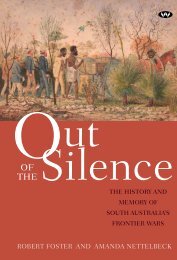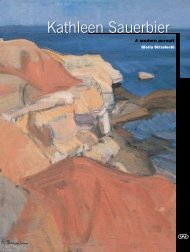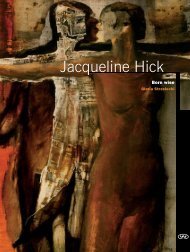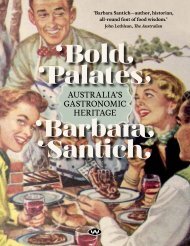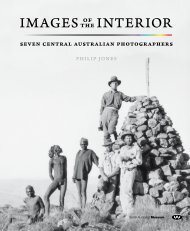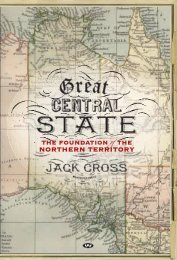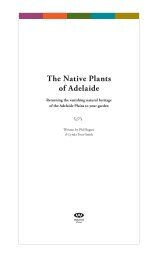stones in the bloodin the southern Flinders Ranges, where many miles of fence were supposedly built by a man withone arm and an Aboriginal woman assistant, about the only source of such ‘knowledge’ is over thecounter at the Hawker Mobil servo.Angus McLachlan lamented to me the greatest mistake he made when he took over runningRosebank Station in the Adelaide Hills in 1970: ‘I didn’t take the time to sit down and talk to theoverseer who had been here for over fifty years, and whose father, Levi Meakins, had built many ofthe wonderful walls throughout the district.’Now I have a dilemma – when is a stone wall really dry-stone? Obviously when no mortar was used.But what about when the mortar was nothing but mud that has eroded away over the years?This book is mainly about the walls that spent their life untouched by mortar. But it does includesome walls that have shed their mortar and impress us because of their history, endurance, beautyor some other compelling attribute.When is a dry-stone wallreally dry?For me a dry-stone wall is when it has no mortar.But Kristin, the photographer, squirms at this andannounces, ‘It must never have had mortar.’ Onthe one hand Kristin says I am snobbish aboutdry-stone walls being special, but then she wantsto disqualify some of the finest old walls inthe State.It seems that I have won this debate as I amwriting about anything that is now dry-stone andshe is shooting them. In fact we have relaxed the criteria further. It is dry-stone for the purpose of thisbook if it now looks dry-stone from all sides. The only mortar used was mud that has weathered awaycompletely or is of the same parent material as the stone and what little remains is barely noticeableto all but the most forensic eye. In fact, you could persuade a sceptic that it is dust that blew in there!We have found some wonderful walls, mainly on shepherds’ huts, stables, stalls and sheds whichwere exposed to the elements when the roof blew off and now show no evidence at all of mortar oneither side. Is it cheating to say that these have defaulted to dry-stone? It means of course that manyruins, particularly in the pastoral country, will now be classified as dry-stone.I built a stone wall at the end of our driveway in 2006. Travelling the State and seeing what othershave done is uplifting but on reflection can be quite depressing. One day I said to Kristin, ‘Our wallhas too many holes I can see light through. Maybe I should knock it down and start again?’7
‘No you won’t!’ she said. ‘That was your practice wall. If you think you can now do better, buildanother one.’It is difficult to appreciate dry-stone walls until you have built at least one. An eye for a nice stonein the paddock, the satisfaction in unearthing a mini-quarry, the grunt of lifting and placing, the Zento accept that this hard-won piece really won’t do and to replace it with another, * and admiration forother works. These are all part of the love affair with stone.At the end of your first day of wall building – lifting rock, twisting vertebrae, crushing fingers –you survey your efforts and despair: ‘Is this all I’ve done?’ But day one is nothing. Day two your handsare sore, week two you walk with a stoop and you might be thinking, This is bad for my health.Of the many folk who have helped me gather material for this book, those most switched on havealready built a wall or two, restored a wall, or at least attempted one of the above. Walling really isabout learning on the job. Stones are not bricks, no two are the same and no one stone looks the samefrom every angle. Nor are all wallers the same, but the one thing most have in common is that theyare short people. They might not have started short, but that’s how they finish. †There is lots of stone where we have lived these past thirty-eight years. The Kanmantoo Systemis a band of schist outcropping across the Eastern Mount Lofty Ranges from about Wistow throughHarrogate, Tungkillo, Springton and Keyneton to Truro. The rock is a host to lichen and the combinedproduct has earned some fame (or notoriety) as ‘moss rock’ that is used and abused as a landscapingfeature in mainly newer suburbs of Adelaide.One-hundred-and-fifty years ago much of this stone was used to build the first dwellings, shedsand fences throughout the district, simultaneously providing shelter and containment whilst clearingthe land of some of the obstacles to farming. Many of the structures are still in use today, providingenduring insights to lives of the early settlers and at the same time displaying the marvellous stonearchitecture that so characterises much of South Australia.We bought Dairy Springs, about midway between Mount Torrens, Tungkillo and Harrogate, in1974; or at least we bought part of it. In those days we could not afford the eastern-most sectionwhich had about a kilometre of stone wall. To be honest the wall didn’t mean much to us back then.But we did think the stone buildings looked pretty, salt damp and all.The core of our house was four rooms built from local stone, while out the back was a two-room(three if you count the loft) stone cottage from which operations commenced in 1896. Over the years,functional but ugly extensions were grafted on and the verandah bricked in to make another room.We had the sense that stone was very much a part of this place but that it was unloved. As everyposthole I dug hit rock, and too often my ute would hit one in the paddock, I could understand howthe early settlers might have had a jaundiced relationship with the local stone.Time passes and one finds use for what is at hand. Flagstones carted back from the paddockscreated paths where needed – and after a while, where not really needed, supply exceeding demand.* Something no serious waller would contemplate – the craftsman, having picked up a stone will not put it down until a place for it is foundin the wall.† A notable exception is the almost legendary Scott Wilson on Kangaroo Island. At six foot five inches in the old money, Scott has such aniconic Aussie style about him that I suspect he will somehow continue to defy gravity where so many before him have failed.8 THOSE DRY-STONE WALLS



